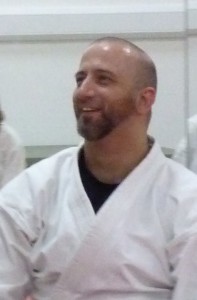“I’m a brown belt; I should be able to do that” by Qaisar Najib
 Quite a while ago at a dojo near me I went for my fix of aikido. A new person came to the dojo that day. He was an MMA practitioner who wanted some training variety.
Quite a while ago at a dojo near me I went for my fix of aikido. A new person came to the dojo that day. He was an MMA practitioner who wanted some training variety.
We were in group training; the technique we were doing involved defence against a punch. In the group was the new person, a brown belt and myself. I took my turn first and the brown belt was up next.
The new guy took a very strong stance you could tell he had been training a little while and he looked like a fighter, strong and relaxed at the same time. He followed proper etiquette and signalled to his partner asking if he was ready. He threw a right cross at the chest of his training partner.
The plan was to move out of the way with a slight tenkan and to engage your training partners mind with an atemi before executing the technique. That was the plan anyway, but things don’t always go to plan. He caught the brown belt square in the chest before he had a chance to even move. It pushed him back taking him off balance. The look on the brown belts face said it all. He wasn’t prepared for that attack. In response he said out loud “I should be able to do that, I’m a brown belt”. He composed himself and started again. This time he got caught also. Frustrated, he started making more errors. He was out of his comfort zone.
It got me thinking that day about how could it be that a person who had been training a long time and had put the hours in. Even bled, sweated and consistently travelled every week to practise couldn’t in that instance do the simplest thing we learn in Aikido, tenkan.
I questioned myself thinking that maybe he was having an off day, so over the next few times I trained at that dojo I watched him and the others training.
I followed how everyone trained not just in this dojo but in others too. It seemed to me that most people training in aikido (not all) lacked the ability to defend against an attacker that had intent to actually hit their training partner. They lacked the combat intensity while training. I understand that at the beginning of your martial arts career you are learning the very basics and the attacks may be slowed or are from a very static position but if someone, as in this case the brown belt had been practising aikido since a very young age. Fourteen years of practise summed up in one technique of the brown belt had me questioning my own technique.
“You can only fight the way you practice” Miyamoto Musashi, A Book of Five Rings
We who do the arts don’t actually like to fight and will avoid using what we have learned on others, as we understand most what devastation and harm it can cause. Saying that we are learning a martial art and in the dojo we must be honest to the martial and the arts aspect of whatever training discipline we follow.
As I practise today and in my teaching I hope I have learned a lesson from that day. We try to keep the combat intensity in training. It is at first scary for any student, going to edge of where there is a possibility of harm and taking control from that point.
There is a far cry from the dojo and real life, but in the dojo, I do believe we should keep the attack as real as possible where uke tries to actually attack nage so that he can achieve a better understanding of the art and himself.
We should also not delude our students and ourselves that we may be able to defend ourselves when (and I hope never) a person you can’t reason with may cross our paths. All we can do is prepare.
“One person practising the art is better than fifty people preaching it” – unknown source

